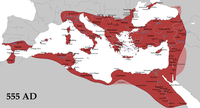
Photo from wikipedia
Background: The present study is part of investigations dedicated to the valorization of the medicinal flora and traditional knowledge of the moroccan central Middle Atlas. It focused on the vernacular… Click to show full abstract
Background: The present study is part of investigations dedicated to the valorization of the medicinal flora and traditional knowledge of the moroccan central Middle Atlas. It focused on the vernacular names of toxic plants used for medicinal purposes in that region. Methods: Through ethnobotanical investigations carried out in the region with herbalists, druggists and traditional practitioners, followed by floristic prospecting in the field, toxic plants used for medicinal purposes in the central Middle Atlas were identified. Their local vernacular names were collected from the surveyed phytotherapists. Then, several scientific publications and books were analysed in order to specify whether the vernacular names are specific to the central Middle Atlas region or are common in Morocco, or even in the Maghreb. Results: In the study area, 83 plants species used for medicinal purposes, belonging to 75 genera and spread over 39 families have been declared toxic; of these 83 plant species, 52 each have only one name in Arabic or Berber dialect, 7 of which are used exclusively in the central Middle Atlas. The 31 other plants are each known by at least two vernaculars, 6 of which are specific to the central Middle Atlas. In Morocco as well as in the other Maghreb countries, most of the inventoried plant species have a multitude of vernacular names, some of which date back hundreds of years. On the one hand, the meaning of these vernacular names alludes to the common use of the plant, one of its morphological particularities, a pigment, a myth or a biotope; on the other hand, it reflects the socio-cultural heterogeneity, firstly in the study area, but especially throughout the country and North Africa. Conclusions: This study made it possible to draw up a non-exhaustive list of vernacular names of toxic plants used as medicine in the central Middle Atlas whose diversity indicates the socio-cultural diversity of the local population and his knowledge of the characteristics and properties of plant species. Key words : Ethnobotany, Toxic plants, Vernacular Names, Diversity, Central Middle Atlas, Morocco, Maghreb Resume Contexte: La presente etude s’inscrit dans une serie de travaux dedies a la valorisation de la flore medicinale et des connaissances endogenes, en l’occurrence le savoir-faire traditionnel du Moyen Atlas central marocain. Elle illustre les appellations vernaculaires des plantes toxiques utilisees a des fins medicinales dans ladite region. Methodes: Par le biais d’investigations ethnobotaniques conduites aupres d’herboristes, droguistes et tradipraticiens, suivies de prospections floristiques sur le terrain, les plantes toxiques a usage medicinal au Moyen Atlas central ont ete identifiees. Leurs noms vernaculaires locaux ont ete recueillis aupres des phytotherapeutes enquetes. Ensuite, plusieurs publications scientifiques et livres ont ete analyses afin de preciser si les appellations vernaculaires sont specifiques a la region du Moyen Atlas central ou bien sont communes au Maroc, voire meme au Maghreb. Resultats: A l’echelle de la zone d’etude, 83 especes vegetales utilisees a des fins medicinales, appartenant a 75 genres et reparties sur 39 familles ont ete declarees toxiques; sur ces 83 especes vegetales recensees, 52 n’ont chacune qu’une seule appellation en dialecte arabe ou berbere dont 7 sont utilisees exclusivement au Moyen Atlas central. Les 31 autres plantes sont connues chacune par au moins deux vernaculaires, parmi lesquels 6 sont specifiques au Moyen Atlas central. Aussi bien au Maroc que dans les autres pays maghrebins, la plupart des especes vegetales recensees possedent une multitude de noms vernaculaires dont certains remontent a des centaines d’annees. D’une part, la signification de ces noms vernaculaires fait allusion a l’usage courant de la plante, l’une de ses particularites morphologiques, un pigment, un mythe ou un biotope; d’autre part, elle reflete l’heterogeneite socioculturelle, d’abord dans la zone d’etude, mais, surtout a travers le pays et l’Afrique du nord. Conclusions: Cette etude a permis de dresser une liste non exhaustive des appellations vernaculaires de plantes toxiques a usage medicinal au Moyen Atlas central, dont la diversite reflete la diversite socioculturelle de la population locale et ses connaissances en caracteristiques et proprietes des especes vegetales. Mots cles: Ethnobotanique, Plantes toxiques, Noms vernaculaires, Diversite, Moyen Atlas central, Maroc, Maghreb.
Journal Title: Ethnobotany Research and Applications
Year Published: 2020
Link to full text (if available)
Share on Social Media: Sign Up to like & get
recommendations!